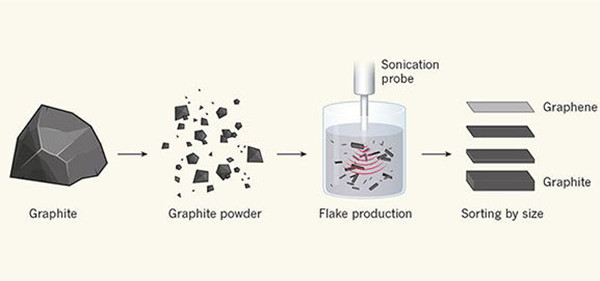Graphite, also known as multilayer graphene, is made up of layers of carbon atoms, each just one bit thick, and its structure determines its superior properties. When graphite sheets are reduced to only a few layers of graphene, essential features such as the total surface area per unit mass of the material and the mechanical properties of the sheet are greatly improved. In other words, graphene is more than just a thin layer of graphite. Unfortunately, many graphene manufacturers don't seem to know the difference or don't care. Kaling et al. .published a systematic study of graphene sold by 60 manufacturers in the journal advanced materials ,and found that many expensive graphene products were fakes made from graphite powder.What would the world be like if everyone could sell antibiotics without following quality standards and laws? Not only are the potential side effects worrisome, but the efficacy is questionable, and even potentially deadly, so many people are deterred from taking antibiotics. Emerging nanomaterials like graphene may not be dangerous, but the lack of industry standards has had equally unacceptable consequences.

One of the most sophisticated methods for the preparation of commercial graphene is the liquid phase exfoliation method, in which graphite is first ground into a powder and then mechanically separated into beautiful graphite flake layers in a solvent. These precious flaps contain a few layers of graphene and are then sifted, as shown in figure 1. The graphene produced by this method can be widely used in battery technology, composite materials, and solar cells. The preparation of graphene by liquid-phase stripping was initially achieved by the process of acoustic degradation of graphene sheets. Later, studies have shown that even kitchen mixers can produce violent turbulence, allowing the separation of graphene layers without damaging them.

Most commercial graphene blocks are made by grinding a stone mill into a powder, then mechanically forcing the graphite powder into tiny flakes in a solvent using methods such as acoustic degradation. The size of the graphite sheet is not shown. Then according to the size and thickness of the graphite sheet layer screening. Kaling et al. 1 analyzed commercial graphene produced by 60 manufacturers and found that most samples contained less than 10% graphene (graphite sheet 5 with fewer than ten layers of carbon atoms). The rest of the examples are necessarily just graphite powder.

But what does the graphene sheet have to be thin to be graphene? It is generally accepted -- and endorsed by ISO, the international organization for standardization -- that if a graphene sheet contains more than ten layers of graphene, it is essentially graphite. Kaling et al. argue that this seemingly arbitrary threshold setting has a physical basis. For example, thermodynamics holds that in graphite sheets with ten or fewer layers of carbon atoms, each carbon atom can maintain the crystalline structure of graphene at room temperature. Furthermore, the hardness of the graphite sheet is proportional to the cube of the thickness of the single layer, which means that the elasticity of the thin graphene sheet is several orders of magnitude higher than that of the thick graphite sheet.

So size matters a lot: in practice, graphene and graphite powder can have very different effects. If there are no clear criteria to identify the quality of commercial graphene and graphite powder is falsely advertised as expensive, and high-quality graphene, companies, and researchers risk wasting time and money on research. This will hinder the development of graphene technology and harm the manufacturers and developers who make graphene seriously.
But are such fears misplaced? In a study that is designed to answer that question, Kaling et al. built on a well-established set of graphene identification methods to establish a systematic test protocol that was used to benchmark 60 graphene products manufactured by different vendors. The research has unnerved many businesses. The results show that there are remarkable differences in the distribution of critical indicators such as material size, structural integrity, and graphene purity. Surprisingly, less than 10 percent of the samples of the majority of products containing graphene contained graphene, a sheet of graphite with fewer than ten layers of carbon atoms. None of the products tested contained more than 50 percent graphene, and most were heavily contaminated, most likely because of chemical contamination during processing.
The high-profile scientific advances, technological breakthroughs, and considerable investments in graphene appear to have opened up a new world for commercial speculators: the study suggests that some manufacturers even price graphene as a black powder whose main ingredient is cheap graphite.
The problem is exacerbated by the unusually low barriers to entry to become a supplier of graphene -- anyone can buy a chunk of graphite, grind it into a powder and then develop a sales website to make money. If you don't introduce accepted standards and testing protocols, you risk further errors. Many of the emerging graphene applications are closely related to socially relevant issues such as health, climate, renewable energy, and sustainable development. If you start with fake graphene, some areas may not make any progress at all.
So Kaling and his colleagues' paper is a necessary wake-up call for graphene manufacturers, buyers, and researchers to agree that everyone benefits from a transparent market for graphene, except for vendors who ignore moral decency and to adhere to strict standards. The ISO graphene dictionary, a document detailing standard terms for graphene, and the national physical laboratory's practical guide to graphene identification have made a good start. Standardization of the graphene market should now continue.
It is worth noting that Kaling et al. did not cover all the large blocks of graphene on the market. And, although they analyzed a large number of products prepared by liquid-phase stripping, the criteria they used to screen them may have been biased, though they have tried to rule that out. They may also have inadvertently missed some of the high-quality graphene made by the best manufacturers. Moreover, they note that graphene is often selected for different properties for different application purposes, making it more difficult to unify quality metrics.
Still, the study is a timely and successful example of the kind of rigorous thinking needed for rapid technological change. Not just for graphene, but for any nanomaterial research that comes to market. Frankly, once there is no quality control, there is no quality at all.
tags: Calcium nitride powder




